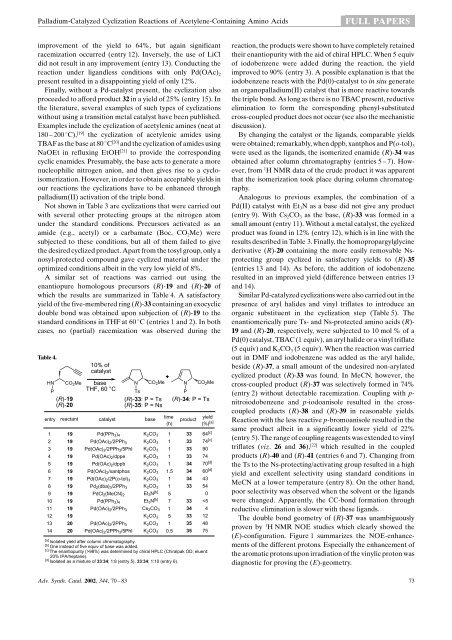Palladium-Catalyzed Cyclization Reactions of Acetylene-Containing ...
Palladium-Catalyzed Cyclization Reactions of Acetylene-Containing ...
Palladium-Catalyzed Cyclization Reactions of Acetylene-Containing ...
Create successful ePaper yourself
Turn your PDF publications into a flip-book with our unique Google optimized e-Paper software.
<strong>Palladium</strong>-<strong>Catalyzed</strong> <strong>Cyclization</strong> <strong>Reactions</strong> <strong>of</strong> <strong>Acetylene</strong>-<strong>Containing</strong> Amino AcidsFULL PAPERSimprovement <strong>of</strong> the yield to 64%, but again significantracemization occurred (entry 12). Inversely, the use <strong>of</strong> LiCldid not result in any improvement (entry 13). Conducting thereaction under ligandless conditions with only Pd(OAc) 2present resulted in a disappointing yield <strong>of</strong> only 12%.Finally, without a Pd-catalyst present, the cyclization alsoproceeded to afford product 32 in a yield <strong>of</strong> 25% (entry 15). Inthe literature, several examples <strong>of</strong> such types <strong>of</strong> cyclizationswithout using a transition metal catalyst have been published.Examples include the cyclization <strong>of</strong> acetylenic amines (neat at180 ± 200 8C), [19] the cyclization <strong>of</strong> acetylenic amides usingTBAFas the base at 80 8C [20] and the cyclization <strong>of</strong> amides usingNaOEt in refluxing EtOH [21] to provide the correspondingcyclic enamides. Presumably, the base acts to generate a morenucleophilic nitrogen anion, and then gives rise to a cycloisomerization.However, in order to obtain acceptable yields inour reactions the cyclizations have to be enhanced throughpalladium(II) activation <strong>of</strong> the triple bond.Not shown in Table 3 are cyclizations that were carried outwith several other protecting groups at the nitrogen atomunder the standard conditions. Precursors activated as anamide (e.g., acetyl) or a carbamate (Boc, CO 2 Me) weresubjected to these conditions, but all <strong>of</strong> them failed to givethe desired cyclized product. Apart from the tosyl group, only anosyl-protected compound gave cyclized material under theoptimized conditions albeit in the very lowyield <strong>of</strong> 8%.A similar set <strong>of</strong> reactions was carried out using theenantiopure homologous precursors (R)-19 and (R)-20 <strong>of</strong>which the results are summarized in Table 4. A satisfactoryyield <strong>of</strong> the five-membered ring (R)-33 containing an exocyclicdouble bond was obtained upon subjection <strong>of</strong> (R)-19 to thestandard conditions in THF at 60 8C (entries 1 and 2). In bothcases, no (partial) racemization was observed during theTable 4.HN CO 2 MeP(R)-19(R)-2010% <strong>of</strong>catalystbaseTHF, 60 °CN CO 2 MeTs(R)-33: P = Ts(R)-35: P = Nsentry reactant catalyst base12345678910111213141919191919191919191919192020Pd(PPh 3 ) 4Pd(OAc) 2 /2PPh 3Pd(OAc) 2 /2PPh 3 /5PhIPd(OAc) 2 /dppePd(OAc) 2 /dppbPd(OAc) 2 /xantphosPd(OAc) 2 /2P(o-tol) 3Pd 2 (dba) 3 /2PPh 3PdCl 2 (MeCN) 2Pd(PPh 3 ) 4Pd(OAc) 2 /2PPh 3Pd(OAc) 2 /2PPh 3Pd(OAc) 2 /2PPh 3 /5PhIK 2 CO 3K 2 CO 3K 2 CO 3K 2 CO 3K 2 CO 3K 2 CO 3K 2 CO 3K 2 CO 3Et 3 N [b]Et 3 N [b]Cs 2 CO 3K 2 CO 3K 2 CO 3K 2 CO 3time(h)111111.511571510.5N CO 2 MeP(R)-34: P = Tsproduct33333333343434333334333535yield(%) [a]64 [c]74 [c]907470 [d]60 [d]4354098%) was determined by chiral HPLC (Chiralpak OD; eluent:20% IPA/heptane).[d] Isolated as a mixture <strong>of</strong> 33:34; 1:8 (entry 5), 33:34; 1:10 (entry 6).reaction, the products were shown to have completely retainedtheir enantiopurity with the aid <strong>of</strong> chiral HPLC. When 5 equiv<strong>of</strong> iodobenzene were added during the reaction, the yieldimproved to 90% (entry 3). A possible explanation is that theiodobenzene reacts with the Pd(0)-catalyst to in situ generatean organopalladium(II) catalyst that is more reactive towardsthe triple bond. As long as there is no TBAC present, reductiveelimination to form the corresponding phenyl-substitutedcross-coupled product does not occur (see also the mechanisticdiscussion).By changing the catalyst or the ligands, comparable yieldswere obtained; remarkably, when dppb, xantphos and P(o-tol) 3were used as the ligands, the isomerized enamide (R)-34 wasobtained after column chromatography (entries 5 ± 7). However,from 1 H NMR data <strong>of</strong> the crude product it was apparentthat the isomerization took place during column chromatography.Analogous to previous examples, the combination <strong>of</strong> aPd(II) catalyst with Et 3 N as a base did not give any product(entry 9). With Cs 2 CO 3 as the base, (R)-33 was formed in asmall amount (entry 11). Without a metal catalyst, the cyclizedproduct was found in 12% (entry 12), which is in line with theresults described in Table 3. Finally, the homopropargylglycinederivative (R)-20 containing the more easily removable Nsprotectinggroup cyclized in satisfactory yields to (R)-35(entries 13 and 14). As before, the addition <strong>of</strong> iodobenzeneresulted in an improved yield (difference between entries 13and 14).Similar Pd-catalyzed cyclizations were also carried out in thepresence <strong>of</strong> aryl halides and vinyl triflates to introduce anorganic substituent in the cyclization step (Table 5). Theenantiomerically pure Ts- and Ns-protected amino acids (R)-19 and (R)-20, respectively, were subjected to 10 mol % <strong>of</strong> aPd(0) catalyst, TBAC (1 equiv), an aryl halide or a vinyl triflate(5 equiv) and K 2 CO 3 (5 equiv). When the reaction was carriedout in DMF and iodobenzene was added as the aryl halide,beside (R)-37, a small amount <strong>of</strong> the undesired non-arylatedcyclized product (R)-33 was found. In MeCN, however, thecross-coupled product (R)-37 was selectively formed in 74%(entry 2) without detectable racemization. Coupling with p-nitroiodobenzene and p-iodoanisole resulted in the crosscoupledproducts (R)-38 and (R)-39 in reasonable yields.Reaction with the less reactive p-bromoanisole resulted in thesame product albeit in a significantly lower yield <strong>of</strong> 22%(entry 5). The range <strong>of</strong> coupling reagents was extended to vinyltriflates (viz. 26 and 36), [22] which resulted in the coupledproducts (R)-40 and (R)-41 (entries 6 and 7). Changing fromthe Ts to the Ns-protecting/activating group resulted in a highyield and excellent selectivity using standard conditions inMeCN at a lower temperature (entry 8). On the other hand,poor selectivity was observed when the solvent or the ligandswere changed. Apparently, the CC-bond formation throughreductive elimination is slower with these ligands.The double bond geometry <strong>of</strong> (R)-37 was unambiguouslyproven by 1 H NMR NOE studies which clearly showed the(E)-configuration. Figure 1 summarizes the NOE-enhancements<strong>of</strong> the different protons. Especially the enhancement <strong>of</strong>the aromatic protons upon irradiation <strong>of</strong> the vinylic proton wasdiagnostic for proving the (E)-geometry.Adv. Synth. Catal. 2002, 344, 70±83 73
















